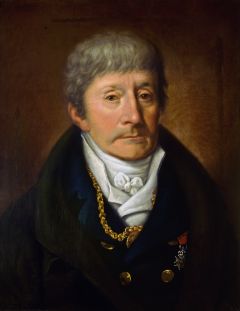Antonio Salieri 1825-2025
Elena Biggi Parodi
Wednesday, May 7, 2025

The following is a guest post from Elena Biggi Parodi (professor of music history and historiography at the Conservatorio “A. Boito” in Parma)
May 7, 2025 marks the bicentenary of the death of Antonio Salieri, the last royal imperial Kapellmeister of the Habsburg court in Vienna. Thanks to his prestigious position during the reign of Joseph II, Leopold II and Franz I, Salieri served as a musical point of reference for all composers of his time, including Mozart. He was a European composer in the broadest sense, blending in his works the influences of Metastasian opera, Neapolitan opera buffa, farce, French opéra comique and tragédie lyrique, pantomime ballet, as well as the reform attempts of Gluck and Calzabigi.
The bulk of Salieri’s musical output for Vienna consists of theatrical works in the buffo genre, but the oeuvre also includes Singspiele in German, tragédies lyriques in French, settings of serious subjects in Italian, masses and sacred (liturgical and not strictly liturgical) works. Salieri also composed for the stages of Italy, Paris and Munich. In his compositions he relied on libretti of the best-known authors of his time: Metastasio, Beaumarchais, Du Roullet, Mazzolà, Da Ponte, Casti and De Gamerra.
In his seminal monograph dedicated to Salieri and Viennese opera (Antonio Salieri and Viennese opera, 1998, 1), the American scholar John Rice observes that during the crucial period of over thirty years that passed from Gluck’s Paride e Elena to Beethoven’s Fidelio, both conceived for Vienna, “there are substantial changes that are not comprehensible by limiting our observation to the works of Gluck and Mozart.” Rice profitably reconsiders the context and reception of Salieri’s operatic production, arguing that “The life and works of Antonio Salieri offer us an opportunity to fill the gaps: to view the last third of the eighteenth century as a single, coherent period in the evolution of Viennese opera and operatic life. […] His operas and his career reflect changes in Viennese opera and musical life during the Classical Period more fully than do the operas and careers of Gluck and Mozart […]. Those who have studied the opere buffe of Mozart’s contemporaries have until recently tended to focus their attention on music by Italian composers not resident in Vienna and to consider only superficially, or not at all, music written in Vienna, for the singers and the audience for whom Mozart wrote.” It is worth remembering that Salieri served as Director of the Italian Opera in Vienna more or less uninterruptedly from 1774 until 1790, adjusting for Vienna the works written in Italy by him and other composers, and also holding the position of Hofkapellmeister until 1824, when the government granted him a full pension until the end of his life.
Antonio Salieri’s scores today
We get to know a composer through his scores. In 2005 a Catalogo tematico delle composizioni teatrali di Antonio Salieri was published in Lucca by the Libreria Musicale Italiana (RISM short title BPI). This pioneering work (edited by the author of these lines) set out to offer scholars – but above all musicians – a chance to get to know, select and locate Salieri’s compositions for the stage. It allows for the identification of the individual arias in each work (which were sometimes reused by the composer in other compositions or modified for celebrated singers of the time), and describes all existing sources of the stage works together with their locations – a vast amount of indispensable information today also available in the RISM database (RISM Catalog | RISM Online).
The main difficulty in performing Salieri’s music for the stage derives from the fact that instrumental and/or vocal parts are often missing in the original sources. Furthermore, there are several manuscript scores of the same work, which contain different versions that were altered for each performance over a period of more than 30 years. In order to perform these works, it is essential to be familiar with the versions known to Salieri’s contemporaries, the different stages of the arrangement process and the changes the composer made on different occasions. The problem is also an aesthetic one, because ignorance of the individual sources (their cuts and fatal omissions) often implies that the musical substance of the composition cannot be fully grasped. Modern editions of Salieri’s works in circulation today often bear witness to a lack of knowledge of the surviving sources, for instance by attributing to Salieri abridgements of his compositions for small ensembles that were in fact undertaken by others (such as in the string quartet versions of some of his overtures). A new edition in keeping with modern scholarly standards is also necessary for the instrumental works, which (although considerably less numerous) were written for the great virtuosos of the time and also provide insight into the larger context. An “Edizione Nazionale Antonio Salieri” is therefore urgently needed to take on the responsibility of an aesthetic evaluation, and to decide which compositions by Salieri should be published to guarantee their presence not only on the shelves of university libraries, but also on the music stands of professional performers and in the classrooms of conservatories, in the hope of an effective “re-circulation” of his music.
The works currently available in modern critical editions include the three masses in D major, D minor, and C major with Te Deum (published in 1994, 2002, and 2016, respectively), a Requiem (edited by Jane Schatkin Hettrick, A-R Editons, 2017), La Passione di Gesu’ Cristo (edited by Elena Biggi Parodi, Suvini Zerboni, Milan, 2000), Prima la musica e poi le parole (edited by Thomas Betzwieser, text edited by A. La Salvia, Bärenreiter-Verlag, Kassel, 2013), Falstaff, ossia le tre burle (edited by Elena Biggi Parodi Casa Ricordi s.r.l., Milan, 2024).
Image: Portrait of Antonio Salieri by Joseph Willibrord Mähler (1815), Available online (public domain).
Share Tweet EmailCatégorie: Evénements

